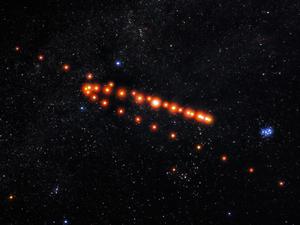Glossary term: Opposition
Description: When two astronomical objects appear to be lined up or nearly lined up with an observer, in opposite directions in the sky, they are said to be in opposition. It is not necessary for both objects to be actually visible for the observer. For instance, at a full moon, the Sun, observer on Earth, and Moon are lined up, so the visible part of the Moon's surface is fully lit up by the Sun – unless the alignment is perfect, in which case there is a lunar eclipse. When a planet, comet, or asteroid is said to be "in opposition", this commonly refers to the Sun and observers on Earth. When a planet is in opposition, it looks particularly bright, appears to move in a direction opposite than usual ("retrograde motion" as Earth moves faster on its inside track), and is particularly close to Earth.
Related Terms:
See this term in other languages
Term and definition status: This term and its definition have been approved by a research astronomer and a teacher
The OAE Multilingual Glossary is a project of the IAU Office of Astronomy for Education (OAE) in collaboration with the IAU Office of Astronomy Outreach (OAO). The terms and definitions were chosen, written and reviewed by a collective effort from the OAE, the OAE Centers and Nodes, the OAE National Astronomy Education Coordinators (NAECs) and other volunteers. You can find a full list of credits here. All glossary terms and their definitions are released under a Creative Commons CC BY-4.0 license and should be credited to "IAU OAE".
If you notice a factual error in this glossary definition then please get in touch.
Related Media
Retrograde Motion of Mars
Credit: Rob Kerby Guevarra/IAU OAE (CC BY 4.0)
License: CC-BY-4.0 Creative Commons Attribution 4.0 International (CC BY 4.0) icons









